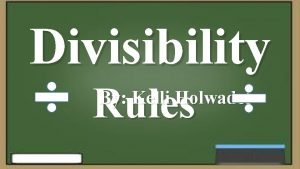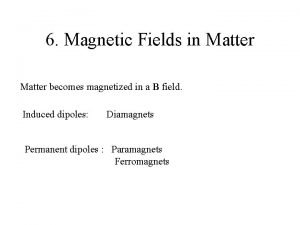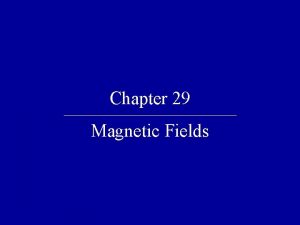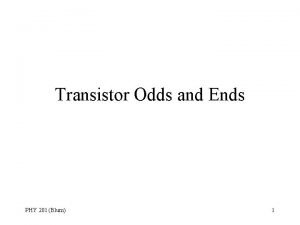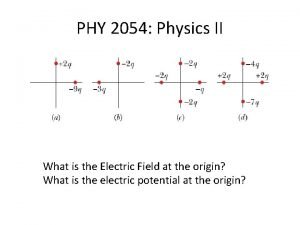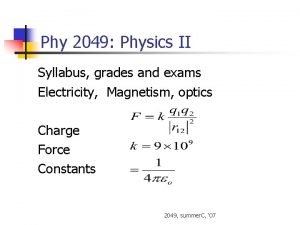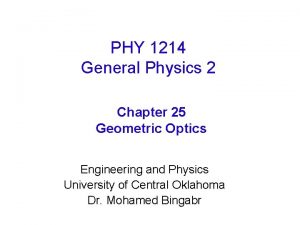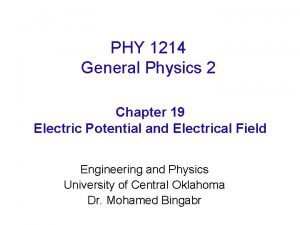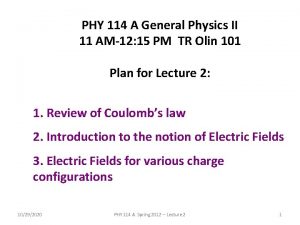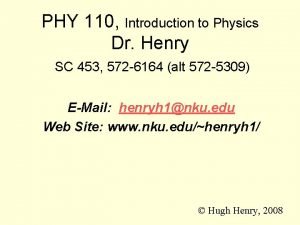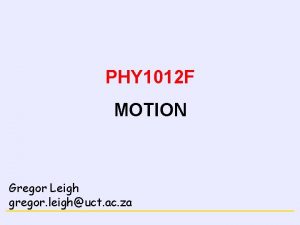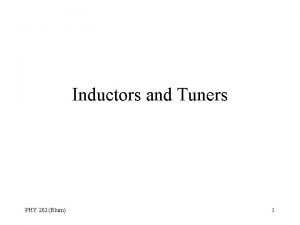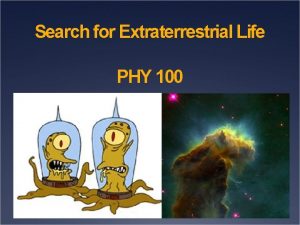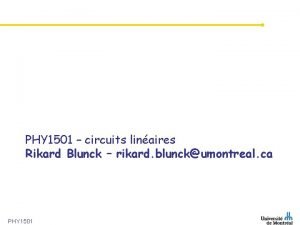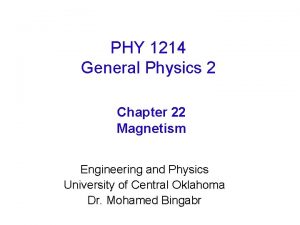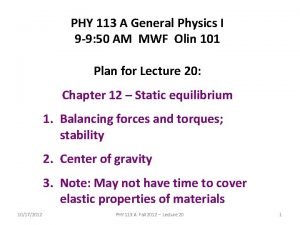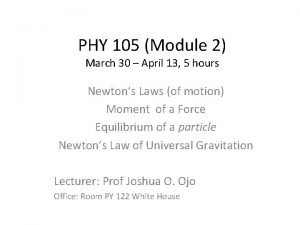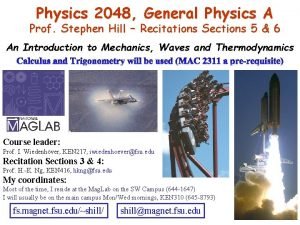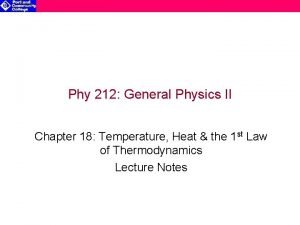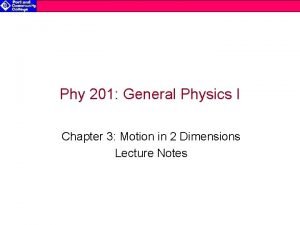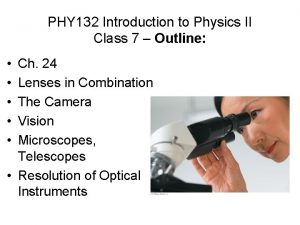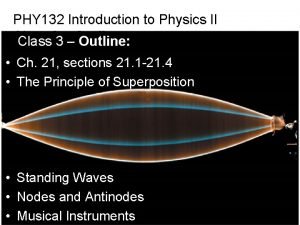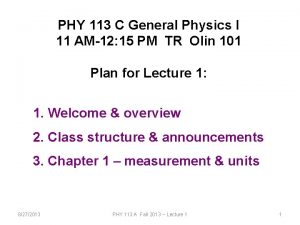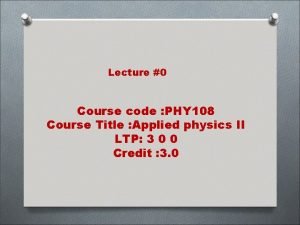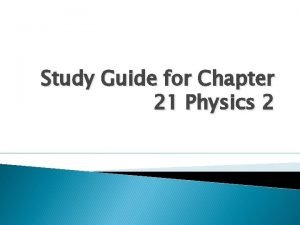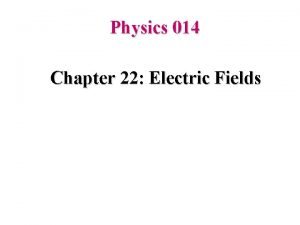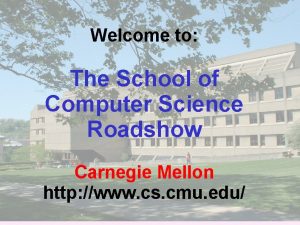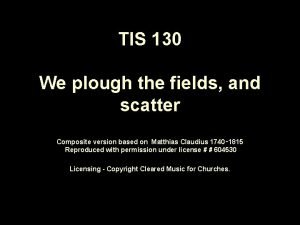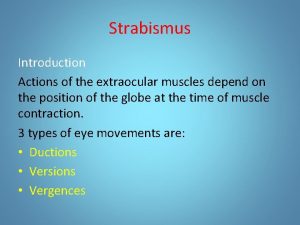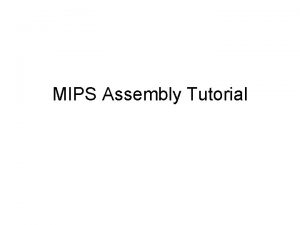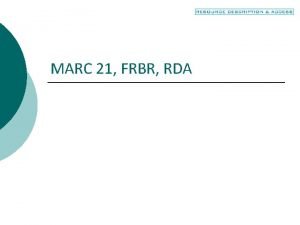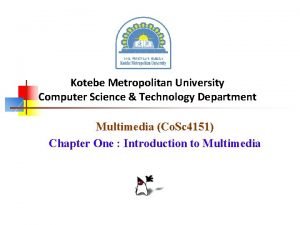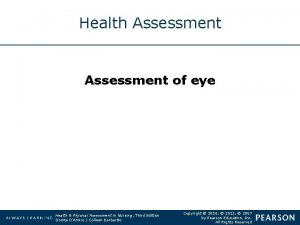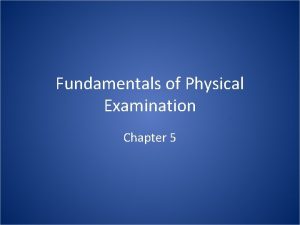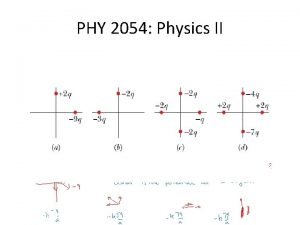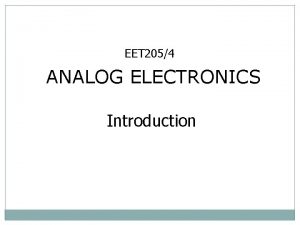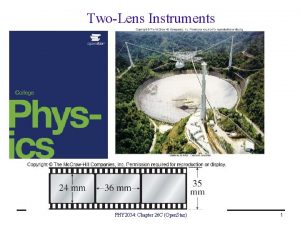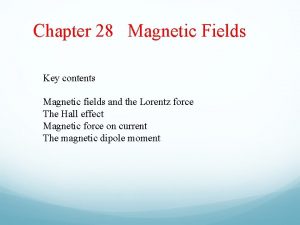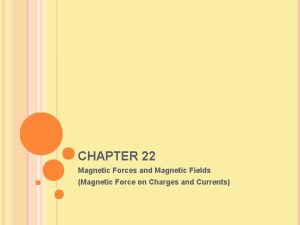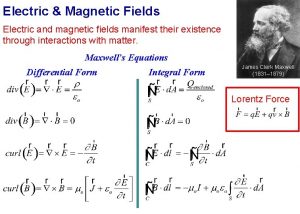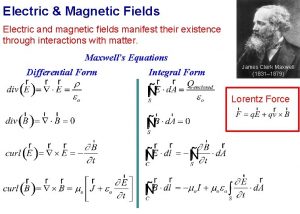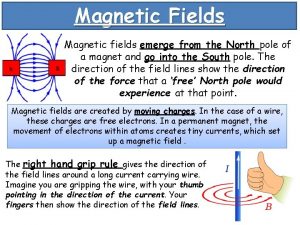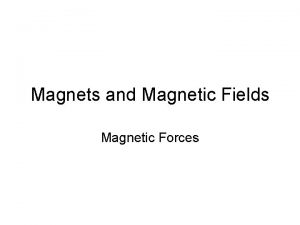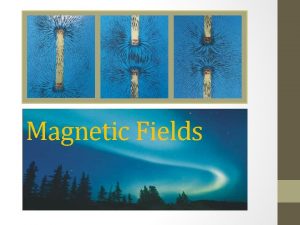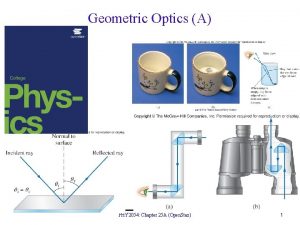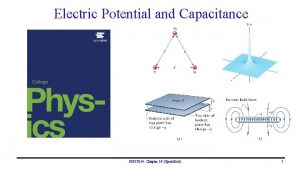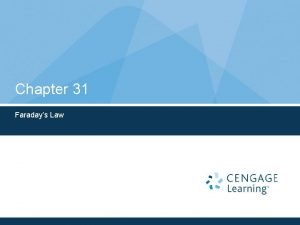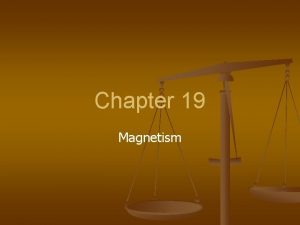Magnetic Fields PHY 2054 Chapter 22 Open Stax









































































- Slides: 73

Magnetic Fields PHY 2054: Chapter 22 (Open. Stax) 1

Chapter 22: Magnetic Fields Ø Magnets, N-S poles, ferromagnets, electromagnets Ø Magnetic fields, field lines Ø Magnetic force on a moving charge, applications Ø Hall effect Ø Magnetic force on a current carrying wire, applications Ø Magnetic torque on a current loop, motors, meters Ø Magnetic fields produced by currents Ø Magnetic force between two parallel conductors Ø More applications PHY 2054: Chapter 22 (Open. Stax) 2

Reading Quiz When I cut a magnet into two pieces I get: u (1) An isolated north and south magnetic pole u (2) Two smaller magnets u (3) The two pieces are no longer magnets PHY 2054: Chapter 22 (Open. Stax) 3

Reading Quiz When I cut a magnet into two pieces I get: u (1) An isolated north and south magnetic pole u (2) Two smaller magnets u (3) The two pieces are no longer magnets PHY 2054: Chapter 22 (Open. Stax) 4

PHY 2054: Chapter 22 (Open. Stax) 5

Example: Bar Magnets Two poles: “north” and “south” u Like poles repel, unlike poles attract Magnetic poles cannot be isolated u Magnetic lines have no beginning or end: always form closed loops u (Like electric field lines when no charges are present) Similar to dipole field from electrostatics PHY 2054: Chapter 22 (Open. Stax) 6

Interaction of Magnetic Poles 1 magnet N–S Attract Similar to electrostatic charges PHY 2054: Chapter 22 (Open. Stax) N–N Repel 7

Magnetic Monopoles? Can any isolated magnetic charge exist? yes! ⇒ “magnetic monopole” (Dirac, 1931) u It would have a + or – magnetic charge on which magnetic lines would start and end u Theoretically, How can we isolate this magnetic charge? u Cut a bar magnet in half? NO! What you get is a bunch of little magnets! Magnetic monopoles have never been seen! Magnetic field lines always form loops PHY 2054: Chapter 22 (Open. Stax) 8

Searches for Magnetic Monopoles PHY 2054: Chapter 22 (Open. Stax) 9

Earth is a Big Magnet! Particles moving along field lines cause Aurora Borealis PHY 2054: Chapter 22 (Open. Stax) http: //en. wikipedia. org/wiki/Aurora_(astronomy) 10

What Causes Magnetism? What is the origin of magnetic fields? u Electric charge in motion! u For example, a current in a wire loop produces a field very similar to that of a bar magnet (as we shall see) Electromagnet Understanding the source of static magnet field lies in understanding currents at the atomic level within matter 1. Orbits of electrons about nuclei 2. Intrinsic electron “spin” (more important effect) PHY 2054: Chapter 22 (Open. Stax) 11

Magnetic Field Units From the expression force on a current-carrying wire: u. B = Fmax / I L u SI unit: u Another common unit: Some Newtons/A⋅m ≡ Tesla 1 gauss = 10− 4 Tesla sample magnetic field strengths: u Earth: B ≈ 0. 5 gauss = 0. 5 × 10− 4 T u Galaxy: B ≈ 10− 6 gauss = 10− 10 T u Bar magnet: B ≈ 100 – 200 gauss u Strong electromagnet: B ≈ 2 T u Superconducting magnet: B ≈ 5 – 10 T u Pulse magnet: B ≈ 100 T u Neutron star: B ≈ 108 – 109 T u Magnetar: B ≈ 1011 T PHY 2054: Chapter 22 (Open. Stax) 12

Pulsars: Rapidly Rotating Neutron Stars Enormous Magnetic Fields Beam off Beam on Crab Pulsar R = 10 km M = 1. 4 solar mass B ≈ 108 T Period = 1/30 sec PHY 2054: Chapter 22 (Open. Stax) 13

Reading Quiz Consider +q moving relative to a B field as shown. What is the direction of the magnetic force? (1) Force is parallel to v u (2) Force is parallel to B u (3) Force is into the page u (4) Force is out of the page u B +q PHY 2054: Chapter 22 (Open. Stax) 14

Reading Quiz Consider +q moving relative to a B field as shown. What is the direction of the magnetic force? (1) Force is parallel to v u (2) Force is parallel to B u (3) Force is into the page u (4) Force is out of the page u B +q PHY 2054: Chapter 22 (Open. Stax) 15

Reading Quiz The magnetic force on a moving charged particle is: u (1) Perpendicular to the velocity u (2) Parallel to the velocity u (3) Parallel to the B field u (4) Independent of the velocity u (5) None of the above PHY 2054: Chapter 22 (Open. Stax) 16

Reading Quiz The magnetic force on a moving charged particle is: u (1) Perpendicular to the velocity u (2) Parallel to the velocity u (3) Parallel to the B field u (4) Independent of the velocity u (5) None of the above PHY 2054: Chapter 22 (Open. Stax) 17

Magnetic Force on Moving Charge Magnetic Force direction is perpendicular to both B and v u Right Force uv hand rule (next slide) direction depends on sign of charge u Force force acts only on moving charge is in opposite direction from positive charge magnitude depends on direction of v relative to B is parallel to B u v is perpendicular to B u v is at angle 45° to B ⇒ sinϕ = 0 ⇒ sinϕ = 1 ⇒ sinϕ = 0. 71 PHY 2054: Chapter 22 (Open. Stax) 18

Direction of Magnetic Force F perpendicular to v and B PHY 2054: Chapter 22 (Open. Stax) 19

Right Hand Rule For Magnetic Force First point fingers in direction of velocity u Curl fingers toward B field u ⇒ Thumb points toward force v F B v +q B F is into page PHY 2054: Chapter 22 (Open. Stax) 20

Example Particle with m = 2. 0 g, q = − 2μC moves with v = 2, 000 m/s through B field of 2. 5 T at an angle of 30° to the field. u Magnitude of force u Direction of force: out of the page (towards you). Use RHR and take opposite direction because of −q v B −q F is out of page PHY 2054: Chapter 22 (Open. Stax) 21

Quiz A charged particle moves in a straight line through some region of space. Can you conclude that B = 0 here? u (1) Yes u (2) No PHY 2054: Chapter 22 (Open. Stax) 22

Quiz A charged particle moves in a straight line through some region of space. Can you conclude that B = 0 here? u (1) Yes u (2) No A B field can exist! If v || B there is no magnetic force PHY 2054: Chapter 22 (Open. Stax) 23

Magnetic Force A negative particle enters a magnetic field region. What path will it follow? u (1) A u (2) B u (3) C u (4) D u (5) E x x x A x x x B x x x x x x x x x x x x x x x PHY 2054: Chapter 22 (Open. Stax) C D E 24

Magnetic Force A negative particle enters a magnetic field region. What path will it follow? u (1) A u (2) B u (3) C u (4) D u (5) E x x x A x x x B x x x x x x x x x x x x x x x C D E (1) RHR says it bends down (− charge) (2) But force cannot instantaneously change v. The direction bends continuously (3) So the answer is D, not E PHY 2054: Chapter 22 (Open. Stax) 25

Trajectory in a Constant Magnetic Field A charge +q enters B field with velocity v perpendicular to B. What path will q follow? u Force is always ⊥ v and ⊥ B u Path will be a circle. F is the centripetal force needed to keep the charge in its circular orbit. Let’s calculate radius R v x x x x B x x x x Fx x x x x x x x x vx x F F v v F q R PHY 2054: Chapter 22 (Open. Stax) 26

Circular Motion of Positive Particle x x x x x x x x x v B x x x x x x x x x F q x x x x x x x x x x x x x x x x x PHY 2054: Chapter 22 (Open. Stax) 27

Cosmic Ray Example Protons with energy 1 Me. V move ⊥ earth B field of 0. 5 Gauss (B = 5 × 10− 5 T). Find radius & frequency of orbit. Frequency is independent of v! PHY 2054: Chapter 22 (Open. Stax) 28

Helical Motion in B Field Velocity of particle has 2 components (parallel to B and perp. to B) u Only v⊥ = v sinϕ contributes to circular motion u v|| = v cosϕ is unchanged v| u So the particle moves in a helical path u v|| is the constant velocity along the B field u v⊥ is the velocity around the circle PHY 2054: Chapter 22 (Open. Stax) v⊥ v ϕ B 29

Helical Motion in Earth’s B Field PHY 2054: Chapter 22 (Open. Stax) 30

Cosmic Rays Follow Helical Motion Around B Field PHY 2054: Chapter 22 (Open. Stax) 31

Magnetic Field and Work Magnetic force is always perpendicular to velocity u Therefore B field does no work! u Why? Because Consequences u Kinetic energy does not change u Speed does not change u Only direction changes u Particle moves in a circle (if ) PHY 2054: Chapter 22 (Open. Stax) 32

Mass Spectrometer PHY 2054: Chapter 22 (Open. Stax) 33

Mass Spectrometer Operation ions first enter a “velocity selector” where E ⊥ B and values are adjusted to allow only undeflected particles to enter mass spectrometer. Positive u Balance forces in selector ⇒ “select” v 2 u Spectrometer: Determine mass from v and measured radius r PHY 2054: Chapter 22 (Open. Stax) 1 34

Mass Spectrometer Example A beam of deuterons travels right at v = 5 × 105 m/s u Velocity selector: Find B such that deuterons with this velocity are undeflected. Assume E = 100, 000 V/m pointing vertically up. u The deuteron beam enters the magnetic spectrometer (B = 0. 6 T). What is the radius of the semicircular orbit of the deuterons? PHY 2054: Chapter 22 (Open. Stax) 35

Magnetic Force Two particles of the same charge enter a magnetic field with the same speed. Which one has the bigger mass? u (1) A u (2) B u (3) Both masses are equal u (4) Cannot tell without more info x x x x x x x x x x x x x x x x x x A PHY 2054: Chapter 22 (Open. Stax) B 36

Magnetic Force Two particles of the same charge enter a magnetic field with the same speed. Which one has the bigger mass? u (1) A u (2) B u (3) Both masses are equal u (4) Cannot tell without more info x x x x x x x x x x x x x x x x x x A Bigger mass means bigger radius PHY 2054: Chapter 22 (Open. Stax) B 37

Quiz: Work and Energy A charged particle enters a uniform magnetic field. What happens to the kinetic energy of the particle? u (1) it increases u (2) it decreases u (3) it stays the same u (4) it changes with the direction of the velocity u (5) it depends on the direction of the magnetic field PHY 2054: Chapter 22 (Open. Stax) 38

Quiz: Work and Energy A charged particle enters a uniform magnetic field. What happens to the kinetic energy of the particle? u (1) it increases u (2) it decreases u (3) it stays the same u (4) it changes with the direction of the velocity u (5) it depends on the direction of the magnetic field Magnetic field does no work, so K is constant PHY 2054: Chapter 22 (Open. Stax) 39

Magnetic Force on Current-Carrying Wire Magnitude of force on current =i Direction of force: RHR PHY 2054: Chapter 22 (Open. Stax) 40

F F PHY 2054: Chapter 22 (Open. Stax) 41

Example A 4 m long wire carries current of 500 A in NE direction u Magnitude of force: B = 0. 5 gauss = 5 × 10− 5 T u Assume B is pointing N with no “dip” u φ = 45° B v u Direction Can of force: Upwards, from RHR adjust current in wire to balance against gravity PHY 2054: Chapter 22 (Open. Stax) 42

Magnetic Force A vertical wire carries a current and is in a vertical magnetic field. What is the direction of the force on the wire? u (1) left u (2) right u (3) zero u (4) into the page u (5) out of the page B I PHY 2054: Chapter 22 (Open. Stax) 43

Magnetic Force A vertical wire carries a current and is in a vertical magnetic field. What is the direction of the force on the wire? u (1) left u (2) right u (3) zero u (4) into the page u (5) out of the page B I is parallel to B, so zero magnetic force I PHY 2054: Chapter 22 (Open. Stax) 44

Torque on Current Loop Consider a rectangular current loop u Forces in left, right branches = 0 u Forces in top/bottom branches cancel u No net force! (true for any shape) But there is a net torque! u Bottom side up, top side down (RHR) u Rotates around horizontal axis μ B b b a Plane normal is ⊥ B here = Ni. A ≡ “magnetic moment” (N turns) u True for any shape!! u Direction of μ given by RHR u Fingers curl around loop and thumb points in direction of μ PHY 2054: Chapter 22 (Open. Stax) 45

General Treatment of Magnetic Moment, Torque μ = Ni. A is magnetic moment (with N turns) u Direction of μ given by RHR θ Torque depends on angle θ between μ and B PHY 2054: Chapter 22 (Open. Stax) 46

Torque Example A 3 -turn circular loop of radius 3 cm carries 5 A current in a B field of 2. 5 T. Loop is tilted 30° to B field. B 30° Rotation always in direction to align μ with B direction PHY 2054: Chapter 22 (Open. Stax) 47

Magnetic Force A rectangular current loop is in a uniform magnetic field. What direction is the net force on the loop? u (1) +x u (2) +y u (3) zero u (4) –x u (5) –y B z y x PHY 2054: Chapter 22 (Open. Stax) 48

Magnetic Force A rectangular current loop is in a uniform magnetic field. What direction is the net force on the loop? u (1) +x u (2) +y u (3) zero u (4) –x u (5) –y Forces cancel on opposite sides of loop. Torques also cancel since forces are identical on opposite sides. B z y x PHY 2054: Chapter 22 (Open. Stax) 49

Hall Effect: Do + or – Charges Carry Current? + charges moving CCW experience upward force Upper plate at higher potential – charges moving clockwise experience upward force Upper plate at lower potential Equilibrium between magnetic (up) & electrostatic forces (down): w = conductor width This type of experiment led to the discovery (E. Hall, 1879) that current in most 50 PHY 2054: Chapter 22 (Open. Stax) conductors is carried by negative charges

Electromagnetic Flowmeter E Ø Moving ions in the blood are deflected by magnetic force Ø Positive ions deflected down, negative ions deflected up Ø This separation of charge creates an electric field E pointing up Ø E field creates potential difference V = Ed between the electrodes Ø The velocity of blood flow is measured using v = E / B PHY 2054: Chapter 22 (Open. Stax) 51

Creating Magnetic Fields Sources of magnetic fields u Spin of elementary particles (mostly electrons) u Atomic orbits (L > 0 only) u Moving charges (electric current) Currents generate the most intense magnetic fields u Discovered Three by Oersted in 1819 (deflection of compass needle) examples studied here u Long wire u Wire loop u Solenoid PHY 2054: Chapter 22 (Open. Stax) 52

B Field Around Very Long Wire Field around wire is circular, intensity falls with distance u Direction given by RHR (compass follows field lines) Right Hand Rule #2 μ 0 = “Permeability of free space” PHY 2054: Chapter 22 (Open. Stax) 53

Visual of B Field Around Wire PHY 2054: Chapter 22 (Open. Stax) 54

B Field Example I = 500 A toward observer. Find B vs r u RHR ur ⇒ field is counterclockwise = 0. 001 m u r = 0. 005 m u r = 0. 01 m u r = 0. 05 m u r = 0. 10 m u r = 0. 50 m u r = 1. 0 m B = 0. 10 T B = 0. 02 T B = 0. 010 T B = 0. 002 T B = 0. 001 T B = 0. 0002 T B = 0. 0001 T = 1000 G = 200 G = 100 G = 20 G = 10 G =2 G =1 G PHY 2054: Chapter 22 (Open. Stax) 55

Charged Particle Moving Near Wire carries current of 400 A upwards u Proton moving at v = 5 × 106 m/s downwards, 4 mm from wire u Find magnitude and direction of force on proton Solution u Direction of force is to left, away from wire u Magnitude of force at r = 0. 004 m v PHY 2054: Chapter 22 (Open. Stax) I 56

Ampere’s Law Take arbitrary path around set of currents u Let ienc be total enclosed current (+ up, u Let Bll be component of B along path Only − down) Not included in ienc currents inside path contribute! u 5 currents inside path u 2 positive (up), 3 negative (down) u 1 outside the path (not included) PHY 2054: Chapter 22 (Open. Stax) 57

Ampere’s Law For Straight Wire Let’s try this for long wire. Find B at distance at point P u Use circular path passing through P (center at wire, radius r) u From symmetry, B field must be circular P r An easy derivation We use this result all the time! PHY 2054: Chapter 22 (Open. Stax) 58

Useful Application of Ampere’s Law Find B field inside long, thick wire (uniform current) u Wire radius R, total current i u Find B at radius r = R / 2 Key fact: enclosed current ∝ area R r PHY 2054: Chapter 22 (Open. Stax) 59

Application of Ampere’s Law (cont) Now use Ampere’s law to find B at any r u Wire radius R, total current i u Let’s do the case r < R first u Again assume uniform current in wire R r (r ≤ R) Rises linearly from 0 to max value at surface PHY 2054: Chapter 22 (Open. Stax) 60

Application of Ampere’s Law (cont) Now find B for r > R R r r≥R Same as if all current were at center of wire PHY 2054: Chapter 22 (Open. Stax) 61

Force Between Two Parallel Currents Force on I 2 from I 1 u RHR Force ⇒ Force towards I 1 on I 1 from I 2 u RHR ⇒ Force towards I 2 Magnetic I 2 I 1 forces attract two parallel currents I 1 PHY 2054: Chapter 22 (Open. Stax) 62

Force Between Two Anti-Parallel Currents Force on I 2 from I 1 u RHR Force ⇒ Force away from I 1 on I 1 from I 2 u RHR ⇒ Force away from I 2 Magnetic I 2 I 1 forces repel two antiparallel currents I 1 PHY 2054: Chapter 22 (Open. Stax) 63

Parallel Currents (cont. ) Look B at them edge on to see B fields more clearly B 2 Antiparallel: repel 1 F 2 1 F B 2 1 B Parallel: attract F 1 2 F PHY 2054: Chapter 22 (Open. Stax) 64

B Field @ Center of Circular Current Loop Radius R and current i: find B field at center of loop From calculus u Direction: If RHR #3 (see picture) N turns close together PHY 2054: Chapter 22 (Open. Stax) 65

Current Loop Example i = 50 A, r = 5 cm, N=20 PHY 2054: Chapter 22 (Open. Stax) 66

B Field of Solenoid Formula found from Ampere’s law ui = current u n = turns / meter u. B ~ constant inside solenoid u B ~ 0 outside solenoid u Most accurate when L >>R Example: un i = 100 A, n = 10 turns/cm = 1000 turns / m PHY 2054: Chapter 22 (Open. Stax) 67

Field at Center of Partial Loop Suppose loop covers angle ϕ u Calculate Use example where ϕ = �� (half circle) u Define Net B field from proportion of full circle direction out of page as positive field is into page PHY 2054: Chapter 22 (Open. Stax) 68

Partial Loops (cont. ) Note on problems when you have to evaluate a B field at a point from several partial loops u Only loop parts contribute, proportional to angle (previous slide) u Straight sections aimed at point contribute exactly 0 Be careful about signs u (a) ⇒ fields add u (b) ⇒ fields partially cancel u (c) ⇒ fields add Note distances from center u Which is larger: (a) or (c)? PHY 2054: Chapter 22 (Open. Stax) 69

Question A high voltage power line 20 m above the ground carries a current of 2000 A. What is the magnetic field due to the current on the ground directly underneath the power line? (µ 0 = 4π × 10− 7 T∙m/A) (1) 35 µT (2) 14 m. T (3) 0. 30 T (4) 20 µT (5) 30 m. T PHY 2054: Chapter 22 (Open. Stax) 70

Question A high voltage power line 20 m above the ground carries a current of 2000 A. What is the magnetic field due to the current on the ground directly underneath the power line? (µ 0 = 4π × 10− 7 T∙m/A) (1) 35 µT (2) 14 m. T (3) 0. 30 T (4) 20 µT (5) 30 m. T PHY 2054: Chapter 22 (Open. Stax) 71

Question A large amount of electrical energy passes down the funnel of a large tornado every second. Measurements taken in Oklahoma at a distance of 9. 0 km from a large tornado showed an almost constant magnetic field of 1. 50 × 10− 8 T associated with the tornado. What was the average current going down the funnel? (µ 0 = 4π × 10− 7 T∙m/A) a. 450 A b. 675 A c. 950 A d. 1500 A PHY 2054: Chapter 22 (Open. Stax) 72

Question A large amount of electrical energy passes down the funnel of a large tornado every second. Measurements taken in Oklahoma at a distance of 9. 0 km from a large tornado showed an almost constant magnetic field of 1. 50 × 10− 8 T associated with the tornado. What was the average current going down the funnel? (µ 0 = 4π × 10− 7 T∙m/A) a. 450 A b. 675 A c. 950 A d. 1500 A PHY 2054: Chapter 22 (Open. Stax) 73
 Marisa asadian
Marisa asadian 2054
2054 Red fields to green fields
Red fields to green fields Learning: module 26: magnetic forces and fields
Learning: module 26: magnetic forces and fields Magnets and magnetic fields lesson 1 answer key
Magnets and magnetic fields lesson 1 answer key Magnetic fields in matter
Magnetic fields in matter Magnetic fields quick
Magnetic fields quick Electric currents and magnetic fields
Electric currents and magnetic fields Visualizing magnetic field
Visualizing magnetic field 영국 beis
영국 beis Difference between magnetic flux and magnetic flux density
Difference between magnetic flux and magnetic flux density Magnetic flux
Magnetic flux Magnetic moment and magnetic field relation
Magnetic moment and magnetic field relation F=i(lxb)
F=i(lxb) Phy 131 past papers
Phy 131 past papers Phy 231 msu
Phy 231 msu The great orthogonality theorem
The great orthogonality theorem Phy 221 msu
Phy 221 msu Phy theorem
Phy theorem Phy 113 past questions and answers
Phy 113 past questions and answers Phy 131 asu
Phy 131 asu Ddr phy architecture
Ddr phy architecture Phy 205
Phy 205 Eye phy
Eye phy Phy 2049
Phy 2049 Phy
Phy Phy
Phy Phy
Phy Atm basics
Atm basics Phy
Phy Phy 2049
Phy 2049 Real image
Real image Phy 1214
Phy 1214 Phy
Phy Law of motion
Law of motion Complete motion diagram
Complete motion diagram Phy
Phy Life phy
Life phy Rikard blunck
Rikard blunck General physics
General physics 2012 phy
2012 phy Phy-105 5 discussion
Phy-105 5 discussion Loncapa fsu
Loncapa fsu Examples of convection
Examples of convection General physics chapters
General physics chapters Phy 1214
Phy 1214 What is farsightedness called
What is farsightedness called Phy 132
Phy 132 Phy 1214
Phy 1214 Phy 108
Phy 108 Phy tgen
Phy tgen Chapter 16: electric forces and fields answers
Chapter 16: electric forces and fields answers Chapter 33 electric fields and potential
Chapter 33 electric fields and potential Chapter 21 study guide electric fields answers
Chapter 21 study guide electric fields answers Chapter 22 electric fields
Chapter 22 electric fields Plc timer symbol
Plc timer symbol Open hearts open hands
Open hearts open hands Conceptual physics magnetism
Conceptual physics magnetism Norm rule fields
Norm rule fields How many fields in computer science
How many fields in computer science Electric forces and fields concept review
Electric forces and fields concept review Plough the fields and scatter
Plough the fields and scatter Breath sounds location
Breath sounds location Alternative cover test
Alternative cover test 6 cardinal fields of gaze
6 cardinal fields of gaze Medusa poem analysis
Medusa poem analysis Slope fields ap calculus
Slope fields ap calculus New consultant training
New consultant training Mips assembly language tutorial
Mips assembly language tutorial Frbr examples
Frbr examples Kotebe metropolitan university fields
Kotebe metropolitan university fields Corneal light reflex
Corneal light reflex Egophony
Egophony Branches of psychology
Branches of psychology

